Coronavirus Voting: Casting Ballots Safely During COVID-19 Pandemic
Voting During The Pandemic: What You Should Know About Coronavirus And Casting Ballots

Source: Grace Cary / Getty
As the most consequential election in our lifetimes approaches, it could also be the most contagious as the coronavirus remains a steady, unfortunate force to be reckoned within the United States. But there are certain health considerations that have put in place in an effort to accommodate people who want to vote in-person as well as those who prefer to cast absentee ballots — all while adhering to the Covid-19 social distancing guidelines that have shaped our existences for the better part of the past six months.
Factoring in how Black and brown people have been disproportionately affected by the coronavirus, the health awareness aspect of Election Day has become particularly important for those underserved populations.
Health standards
While the Centers for Disease Control (CDC) have provided health recommendations for all polling places, discretion and final say are being left up to local jurisdictions — and, of course, voters, who have more electoral choices this time around than they may realize.
With the growing concern over in-person voting, polling places have been asked to do all they can to provide the cleanest and most sterile environment they can. That includes providing voters with an “alcohol-based hand sanitizer with at least 60% alcohol for use at each step in the voting process where voters interact with poll workers, after using the voting machine, and as the final step in the voting process,” the CDC said.
The government health agency also is encouraging polling place workers to wash their hands frequently. Masks are also all but mandatory except for babies and children younger than two years old, people with breathing problems, or those who otherwise need related assistance.
But the environment in which you vote is not entirely left up to the polling places and their workers. Here’s what voters can do to play a more pro-active role health-wise while casting their ballots in the middle of a pandemic.

Source: fstop123 / Getty
“If you’re in an area that has really gotten control of Covid-19, and it’s having very little spread in the community, that’s safer than areas that are having,” Dr. Marybeth Sexton, an assistant professor of medicine in the division of infectious diseases at Emory University in Atlanta, told CNN.
Polling places could also have plexiglass divisions to separate voters and poll workers in an effort to minimize touching of any kind. With that said, in-person voters are still encouraged to wear personal protective equipment other than masks, like gloves and even face shields and visors.
Changes made to the voting process
With the partisan mail ballots controversy still brewing, in-person voting is still very much an option — and it doesn’t necessarily have to be at a polling place, either.
For instance, absentee ballots typically require reasons for not being able to vote in-person — like sickness or traveling for business — but the coronavirus has eliminated that barrier this year. So anyone with coronavirus concerns keeping them from their polling places can request an absentee ballot to either mail via the U.S. Postal Service or to vote early by dropping off the ballot in-person ahead of Election Day.
Both methods practice social distancing and will keep voters away from lines that could look longer than they really are as people stand a recommended 6 feet apart from each other.
Another change made to the voting process this year could include more poll workers than usual. “Then they may be able to move people through so that people aren’t standing in line for a long period of time,” Sexton said.

Source: LPETTET / Getty
But if voters can cast their ballots early — say, by dropping them off in advance at their local boards of election, where some may even have curbside options — then they are encouraged to do so, as well.
“If election workers are doing curbside voting, we would want them to have additional PPE like gloves, a face shield and a face mask,” said Hannah Klain, an Equal Justice Works fellow in the democracy program at the Brennan Center for Justice.
If there is still uncertainty for some voters about how they should proceed, it can’t hurt to reach out to members of local government to learn more about what safety and health considerations and changes have been made.
Have a plan and stick to it
With crucial deadlines rapidly approaching — voter registration, requesting absentee ballots, voting early — Sexton said it was prudent for voters to have a plan in place and not to stray from it.
“I put voting in the same category as getting kids back to school — these are things that should be really important to us,” Sexton said. “So this is a time to continue to limit large gatherings, avoid in-person dining and not be at bars and parties, because the level of virus in the community is going to determine how safe it is to vote in person. So everything we can do to make the community safer ahead of time will make voting safer.”
Having a plan means being prepared, like bringing your own pen instead of using one provided by the polling place or borrowing one from a fellow voter in case there is a need to sign a voter card or mark a paper ballot.

Source: adamkaz / Getty
Vote!
Now you know what to expect, there’s only one thing left to do: practice your civic duty and participate in the democratic process by voting.
SEE ALSO:
Mail Ballots vs. In-Person Voting: Everything You Need To Know
Don’t Believe The Hype: Mail-In Voting Is Safe, Reliable And Trustworthy

















